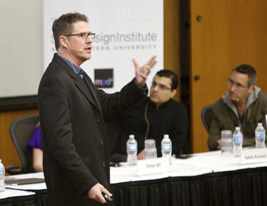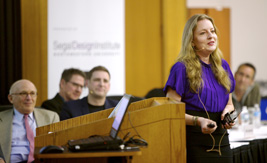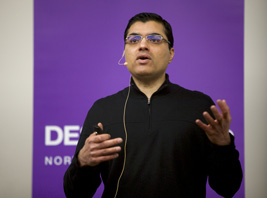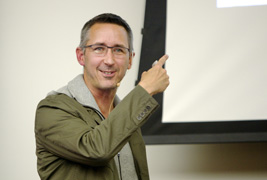Panelists Discuss Intra/Entrepreneurship at Design:Chicago
Entrepreneurs discussed the benefits of design thinking in the world place.
Watch the Design:Chicago 2014 presentations.
While great design is done by great designers, it is important for business leaders to be invested as well. The business leaders need to see the importance of design and foster creative thinking in the office.
“Design leadership is founded on business leadership,” said Kevin Gilboe, head of global design for 3M. “Design is everyone’s job.”
Gilboe (MPD ’07) was one of the panelists for this year’s Design:Chicago, which focused on the theme of “Designers as Intra/Entrepreneurs.” The James Allen Center’s McCormick Auditorium was packed on April 3 with an audience excited to see a panel of entrepreneurs from the design industry.

Now in its seventh year, Design:Chicago brings together the Northwestern community, the public, and top designers and executives from the professional world to discuss topics and challenges in design.
Gilboe leads an international, award-winning team of design experts in building innovative new products for consumers. He talked about the “quiet power of space” and how designers worked together to turn 3M’s drab cubicles into a colorful, open office space.
“There is a powerful act in creating space,” Gilboe said. “We needed a collaborative center. Without it, we wouldn’t have design. We wouldn’t have the right ecosystem for design.”
The well-designed atmosphere has inspired and enhanced innovation within the company. According to Gilboe, instead of merely creating functional office tools, 3M strives to “bring delight into the home” with a bright and colorful “candy store of products.”
Products are not the only things that can benefit from good design. Kristian Hammond, professor of electrical engineering and computer science, said communication should be approached as a design problem.
Hammond is the cofounder and chief scientist of Narrative Science, a company that uses design to turn data into stories and insights. Narrative Science’s product Quill looks at data and transforms it into more understandable narrative descriptions.

The problem with data, he said, is that few people can look at it and easily make sense of the numbers. Many companies now create visualizations to help individuals more easily understand data. However, even with visualizations, people are still forced to work hard to mine the underlying story.
“Quill takes the data and gives not a story of the data, but a story of world with data as a source of the truth,” Hammond said.
While Narrative Science is already serving many business clients to help them better understand financial reports, Hammond sees a more powerful use for Quill by applying it to individuals. One example is using Quill to help students make sense of standardized test results.
“We can explain what they need to study and what they need to do,” Hammond said. “We can put together a personalized document for everyone in the world—documents that a human being will never be able to build.”
Elisa All (GJ ’95), founder and CEO of 30Second Mobile, also uses design to tell stories more effectively. 30Second Mobile is a mobile-first media company that builds relationships with consumers through 30-second videos, which All calls “snackable content.”

30Second Mobile developed from All’s website iParenting, which she sold to Disney in 2007. At the time, she recognized that mobile and social media were a growing trend but did not see other sites offering quick videos. Discovering a niche, she said, is a key to entrepreneurial success.
“Entrepreneurship is not for the faint of heart,” she said. “It’s one of the toughest things you can do.”
Design thinking can lead to game-changing innovations and major breakthroughs, but, unfortunately, that does not mean it’s accepted everywhere. Iqbal Arshad (MEM ’97), senior vice president of engineering and global product development, at Motorola Mobility, warns that typical corporate structures encourage old-fashioned ways of thinking.
Arshad said today’s companies often hire individuals to work in silos, which impedes collaboration on big ideas. He said entrepreneurs can work around this by inventing new business models that apply system-level design thinking.
When leading the development of Motorola’s Moto X, Arshad said he continually asked himself how to make smart phones smarter. Rather than focusing on individual parts of the phone to improve, Arshad wanted to create a fundamentally different user experience. His team ended up creating a phone that follows voice directions without needing to be touched or even turned on.
“Look at the system as a whole,” he said, “to solve a simple problem.”

“It’s a long journey to instant success,” he said. “It can happen, but it’s a hard road with a lot of resets along the way.”
Like Gilboe, Wilson wanted MINIMAL to have an environment that inspired big ideas and collaboration. He aimed to make conferences more conversational but placed an emphasis on doing rather than talking. “Talk is cheap?” he quipped. “Actually it’s really expensive if you are sitting around talking and not doing anything.”
Wilson urged entrepreneurs in the audience to “activate superfans.” Wilson used Kickstarter to fund TikTok and LunaTik, which transform the iPod Nano into multi-touch watches. Having raised nearly $1 million in 30 days, it was one of the most successful crowd-funding stories in history. Inspired by the power of supporters, Wilson created the LUNATIK Rewards App that pays cash-based commission to TikTok and LunaTik users who spread the word about the products.
“Consumers trust word-of-mouth recommendations,” he said. “We came up with the app by using design thinking to connect the dots.”